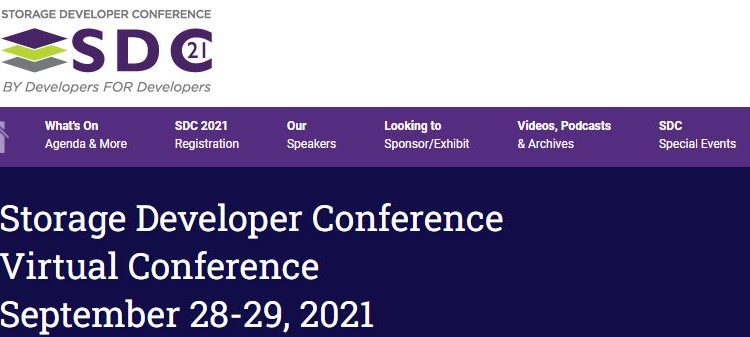
Category: New & Events

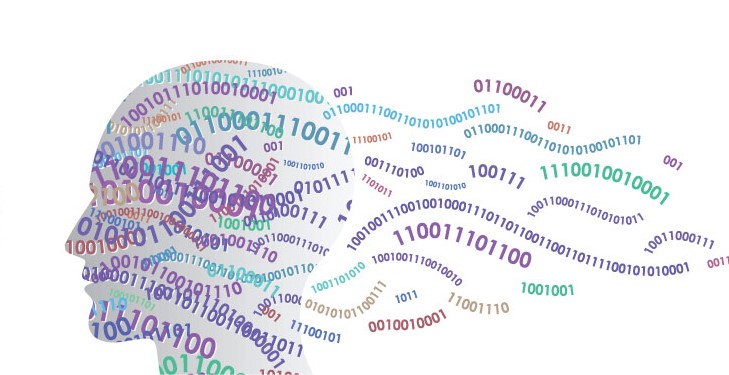
Dive – or Dip – into SNIA Persistent Memory + Computational Storage Summit Content

Continuing to Refine and Define Computational Storage

Answering Your Questions on EDSFF
See You (Online) at SDC!

Take 10 – Watch a Computational Storage Trilogy
We’re all busy these days, and the thought of scheduling even more content to watch can be overwhelming. Great technical content – especially from the SNIA Educational Library – delivers what you need to know, but often it needs to be consumed in long chunks. Perhaps it’s time to shorten the content so you have more freedom to watch.
With the tremendous interest in computational storage, SNIA is on the forefront of standards development – and education. The SNIA Computational Storage Special Interest Group (CS SIG) has just produced a video trilogy – informative, packed with detail, and consumable in under 10 minutes!
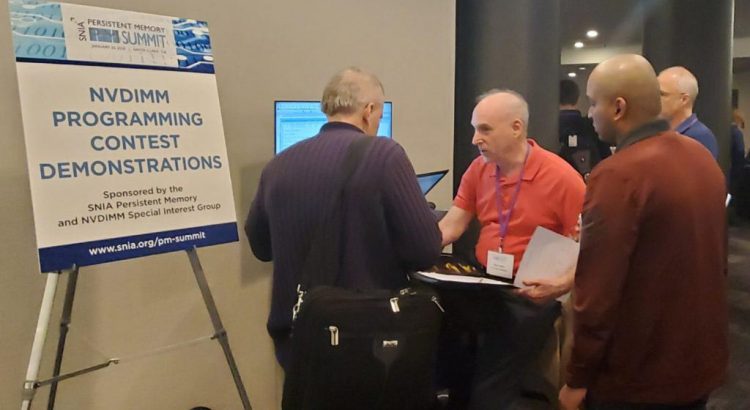
Up to the Challenge!
Judging Has Begun – Submit Your Entry for the NVDIMM Programming Challenge!
We’re 11 months in to the Persistent Memory Hackathon program, and over 150 software developers have taken the tutorial and tried their hand at programming to persistent memory systems. 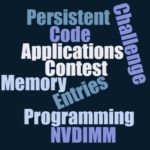 AgigA Tech, Intel, SMART Modular, and Supermicro, members of the SNIA Persistent Memory and NVDIMM SIG, have now placed persistent memory systems with NVDIMM-Ns into the SNIA Technology Center as the backbone of the first SNIA NVDIMM Programming Challenge.
AgigA Tech, Intel, SMART Modular, and Supermicro, members of the SNIA Persistent Memory and NVDIMM SIG, have now placed persistent memory systems with NVDIMM-Ns into the SNIA Technology Center as the backbone of the first SNIA NVDIMM Programming Challenge.
Interested in participating? Send an email to PMhackathon@snia.org to get your credentials. And do so quickly, as the first round of review for the SNIA NVDIMM Programming Challenge is now open. Any entrants who have progressed to a point where they would like a review are welcome to contact SNIA at PMhackathon@snia.org to request a time slot. SNIA will be opening review times in December and January as well. Submissions that meet a significant amount 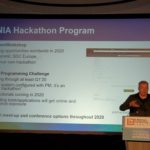 of the judging criteria described below, as determined by the panel, will be eligible for a demonstration slot to show the 400+ attendees at the January 23, 2020 Persistent Memory Summit in Santa Clara CA.
of the judging criteria described below, as determined by the panel, will be eligible for a demonstration slot to show the 400+ attendees at the January 23, 2020 Persistent Memory Summit in Santa Clara CA.
Your program or results should be able to be visually demonstrated using remote access to a PM-enabled server. Submissions will be judged by a panel of SNIA experts. Reviews will be scheduled at the convenience of the submitter and judges, and done via conference call.
NVDIMM Programming Challenge Judging Criteria include:
Use of multiple aspects of NVDIMM/PM capabilities, for example:
- Use of larger DRAM/NVDIMM memory sizes
- Use of the DRAM speed of NVDIMM PMEM for performance
- Speed-up of application shut down or restart using PM where appropriate
- Recovery from crash/failure
- Storage of data across application or system restarts
Demonstrates other innovative aspects for a program or tool, for example:
- Uses persistence to enable new features
- Appeals across multiple aspects of a system, beyond persistence
Advances the cause of PM in some obvious way:
- Encourages the update of systems to broadly support PM
- Makes PM an incremental need in IT deployments
Program or results apply to all types of NVDIMM/PM systems, though exact results may vary across memory types.
Questions? Contact Jim Fister, SNIA Hackathon Program Director, at pmhackathon@snia.org, and happy coding!
Learn the Latest on Persistence at the 2020 Persistent Memory Summit
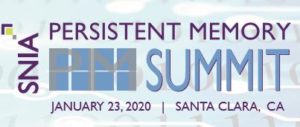 The day before, on January 22, an expanded version of the SNIA Persistent Memory Hackathon will return, co-located again with the SNIA Annual Members Symposium. We’ll share Hackathon details in an upcoming SNIA Solid State blog.
For those who have already attended a Persistent Memory Summit, you will find significant changes in the makeup of the agenda. For those who have never attended, the new agenda might also be an opportunity to learn more about development options and experiences for persistent memory.
The focus of the 2020 Summit will be on tool and application development for systems with persistent memory. Read More
The day before, on January 22, an expanded version of the SNIA Persistent Memory Hackathon will return, co-located again with the SNIA Annual Members Symposium. We’ll share Hackathon details in an upcoming SNIA Solid State blog.
For those who have already attended a Persistent Memory Summit, you will find significant changes in the makeup of the agenda. For those who have never attended, the new agenda might also be an opportunity to learn more about development options and experiences for persistent memory.
The focus of the 2020 Summit will be on tool and application development for systems with persistent memory. Read More
It’s a Wrap for SNIA and the Solid State Storage Initiative at Flash Memory Summit 2019
 SNIA volunteers were again recognized for their hard work developing standards for datacenters and storage professionals with a “Most Innovative Flash Memory Technology” FMS Best of Show award. This year, it was SNIA’s Object Drive Technical Work Group who received kudos for the SNIA Technical Position Key Value Storage API Specification. Jay Kramer, head of the FMS awards program, presented the award to Bill Martin, Chair of the Object Drive TWG, commenting “Key value store technology can enable NVM storage devices to map and store data more efficiently and with enhanced performance, which is of paramount significance to facilitate computational storage. Flash Memory Summit is proud to recognize the SNIA Object Drive Technical Work Group (TWG) for creating the SNIA Technical Position Key Value Storage API Specification Version 1.0 defining an application programming interface (API) for key value storage devices and making this available to the public for download.
SNIA Sessions at FMS Now Available for Viewing and Download Read More
SNIA volunteers were again recognized for their hard work developing standards for datacenters and storage professionals with a “Most Innovative Flash Memory Technology” FMS Best of Show award. This year, it was SNIA’s Object Drive Technical Work Group who received kudos for the SNIA Technical Position Key Value Storage API Specification. Jay Kramer, head of the FMS awards program, presented the award to Bill Martin, Chair of the Object Drive TWG, commenting “Key value store technology can enable NVM storage devices to map and store data more efficiently and with enhanced performance, which is of paramount significance to facilitate computational storage. Flash Memory Summit is proud to recognize the SNIA Object Drive Technical Work Group (TWG) for creating the SNIA Technical Position Key Value Storage API Specification Version 1.0 defining an application programming interface (API) for key value storage devices and making this available to the public for download.
SNIA Sessions at FMS Now Available for Viewing and Download Read More